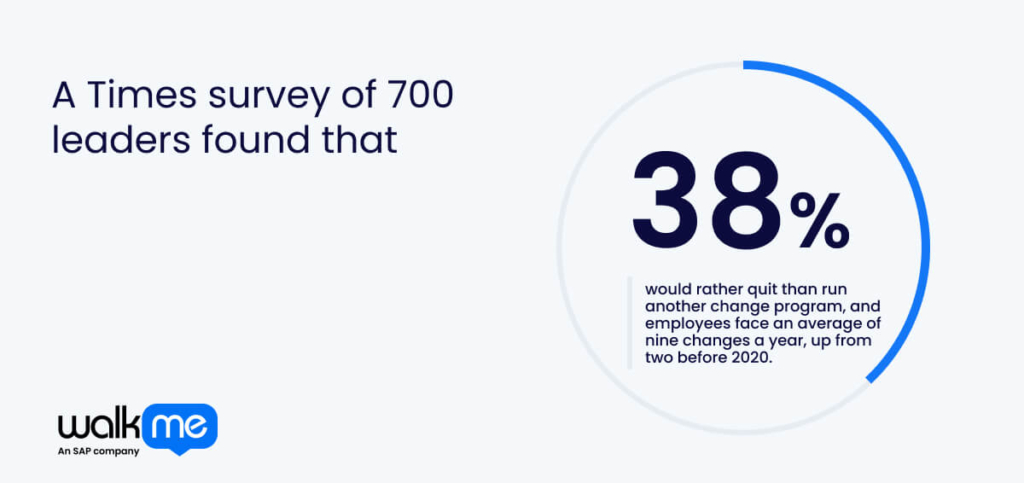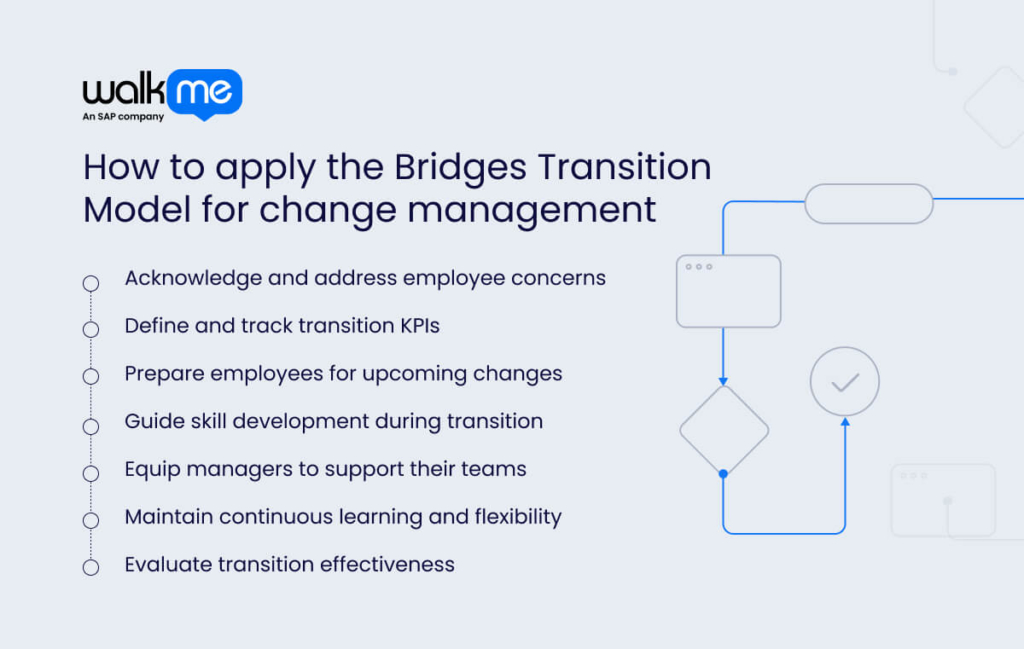Enterprises are under constant pressure from new technologies, diversifying markets, and internal reorganizations.
Modern change management requires helping people navigate through endings, uncertainty, and new beginnings. The Bridges Transition Model serves as a framework for managing that inner journey.
A Times survey of 700 leaders found that 38% would rather quit than run another change program, and employees face an average of nine changes a year, up from two before 2020. These figures highlight the challenge of managing the emotional strain of change.

With that in mind, this article examines the Bridges Transition Model, including its definition, operational framework, and how leaders can use it to guide teams through authentic, human-centered transitions.
What is the Bridges Transition Model?
The Bridges Transition Model explains how people emotionally move through change in three phases. These include:
- Ending what’s familiar
- Navigating the uncertainty of the middle
- Embracing a new beginning
It shows leaders how to guide people through the human side of change. For enterprises, it’s a way to keep teams engaged while transformations unfold and can be likened to a playbook for the emotional side of big company shake-ups.
The model is designed to help people handle the messy parts of change so they don’t feel lost along the way. It provides leaders with a way to keep everyone moving forward together until the new beginning feels tangible and attainable.
Why is the Bridges Transition Model important?
The Bridges Transition Model is vital because it places the human experience front and center during change.
Many organizations overlook the human side of change. This model helps leaders address uncertainty, support teams, and build momentum for future transformations.
Change management leaders who embrace it see less resistance, higher employee engagement, and faster adoption, mostly because staff feel understood rather than managed.
Change often works best when it is shared and not imposed. People tend to engage better, and transitions proceed with less friction. When uncertainty is managed, it opens the door to new opportunities and results in a transformation that teams own and sustain together.
A key takeaway is that focusing on the emotional and psychological journey of employees is just as crucial as the technical or strategic aspects of change.
What are the three stages of the Bridges Transition Model?
Understanding change is a lot more complex than you might think. Businesses often get caught up in new processes or tools, but it’s about how people experience it.
The Bridges Transition Model breaks this journey into three distinct stages:
Ending stage
The ending stage is when employees face the reality that familiar routines, roles, or processes are changing. This often brings tension, disappointment, or resistance; leaders who ignore it risk losing trust and engagement. Leaders who acknowledge endings and guide their employees through the emotions associated with them help them let go and prepare for what comes next.
Neutral zone
The neutral zone is like a liminal space, where confusion and experimentation coexist. Teams may feel disoriented or uncertain, yet innovation often flares as leaders guide people through ambiguity by offering support, setting short-term milestones, and celebrating wins. This is a space for learning, where mistakes teach insight. Honest communication helps employees adapt, build readiness for change, and ultimately set the stage for full change adoption.
New beginning
The new beginning stage focuses on ownership and energy. Employees adopt new roles and behaviors with clarity and purpose. Then, leaders reinforce commitment by linking responsibilities to organizational alignment goals. Storytelling, rituals, and recognition boost motivation and cement habits. The new beginning transforms apprehension into confidence, cultivating a sense of achievement. Momentum grows as results become visible, ensuring change is embedded, celebrated, and sustained.
How to apply the Bridges Transition Model for change management

Real change only sticks when people move with it and not against it. Learning how to apply the Bridges Transition Model shows leaders how change can succeed through people. Let’s take a closer look at how to apply the Bridges Transition Model for change management:
Acknowledge and address employee concerns
Ignoring emotions is the fastest way to stall change. Leaders must listen and give employees space to share their thoughts. Focus on real frustrations and uncertainties, and communicate with transparency. Addressing concerns early reduces resistance and keeps teams engaged. This means using forums, one-on-one check-ins, or surveys to uncover hidden issues. True acknowledgment goes beyond empathy and builds a foundation where people feel seen, heard, and ready to engage with the change.
Define and track transition KPIs
Change without measurable indicators is no more than guesswork. Set KPIs that track adoption rates, engagement, or skill development. Then, monitor them regularly to spot where progress stalls. It’s a good idea to link KPIs to meaningful outcomes to see if employees are moving through the transition stages. Sharing these results promotes accountability and shows where leadership should focus support. When used correctly, metrics can turn conceptual change into viable progress.
Prepare employees for upcoming changes
Change feels less daunting when people know what to expect. Leaders should provide clear explanations of what is shifting, why it matters, and how roles will adapt. Then, offer employees practical tools to explore the impact safely. Workshops, briefings, and scenario exercises let teams test ideas, ask questions, and build confidence. Remember, framing change as an opportunity highlights new responsibilities and career growth.
Guide skill development during transition
Change requires new skills, and employees need guidance to feel capable of adapting to these new skills. If gaps in learning are identified early on, employees take more ownership and help guide their own paths. Hands-on practice and peer mentoring allow employees to learn on the job, improving confidence and morale through a shared sense of ownership. Tracking progress highlights growth and signals where extra support is needed, ensuring employee training needs are met and investment in skills actually pays off.
Equip managers to support their teams
Managers are the human bridge between strategy and execution. Equip them to recognize employee burnout and manage technostress early on. Train managers to ask meaningful questions, provide clear feedback, and celebrate progress. Support includes playbooks and coaching frameworks, enabling them to turn strategy into action. Well-prepared managers ease individual transitions, maintain morale, drive engagement, and anchor organizational stability throughout uncertain periods.
Maintain continuous learning and flexibility
Continuous learning is often discussed, but few teams truly embody it. Change is messy, and employees need space to experiment, fail safely, and adjust as they go. Build real feedback loops, encourage cross-functional team problem-solving, and reflect quickly on lessons learned. When leaders model adaptability, course corrections stop feeling like mistakes and begin to become opportunities. In this regard, flexibility turns uncertainty into growth and keeps the organization resilient.
Evaluate transition effectiveness
Change is only meaningful when people feel its effects, not just when metrics improve. Start by combining hard data against initial KPIs and with employee feedback to uncover what honestly worked and what didn’t. Then act on those insights so teams see their experiences shaping decisions. Reflection like this turns transitions into lasting growth, strengthens culture, and equips the organization to adapt smarter in the future.
What are the benefits of the Bridges Transition Model?
Enterprises often underestimate the hidden friction that comes with change. Recognizing this helps leaders uncover what drives engagement, performance, and adoption, making it easier to shape transitions that stick.
Let’s take a closer look at the benefits of the Bridges Transition Model:
Reduces employee resistance
The Bridges Transition Model lowers resistance by structuring change around human reactions rather than deadlines or outputs. It does this by explicitly identifying what employees are leaving behind, the uncertainties they will face, and what is to come next. Addressing these stages reduces fear and confusion, allowing employees to transition from questioning or resisting change to understanding its necessity and actively participating.
Guides teams through change
Teams navigate change more effectively because the model gives a clear roadmap of emotional and operational phases. Employees understand the reason for shifts, the gaps they need to bridge, and the expected outcomes. This clarity prevents duplicated efforts, reduces miscommunication, and allows teams to focus on implementing the change step by step.
Supports targeted leadership actions
Leaders benefit from actionable insights into team sentiment and readiness. The model highlights where intervention is needed, whether it’s coaching, clarifying roles, or reinforcing behaviors. This enables leaders to act precisely, allocating support and resources where engagement lags, rather than issuing blanket directives.
What are the challenges of the Bridges Transition Model?
While the Bridges Transition Model highlights the human side of change, putting it into practice can be tricky. Organizations often struggle to anticipate emotional responses, making it challenging to guide teams without missteps.
Let’s take a closer look at the challenges of the Bridges Transition Model:
No structured change management process
The Bridges Transition Model excels at guiding emotions, but it doesn’t hand you a step-by-step playbook. Leaders without their own structure may flounder, with conversations about endings being skipped, uncertainty ignored, and teams drifting without purpose. Without scaffolding, human-focused insights remain ideas on paper rather than having a tangible impact.
No guidance on measurement
Emotional progress isn’t easily quantified, and the model doesn’t prescribe metrics. Organizations struggle to track adoption, employee engagement, or the ripple effects of transitions. Without concrete indicators, it’s hard to adjust tactics midstream. This often leaves leaders uncertain whether interventions are effective or merely create the illusion of progress.
Limited scalability
What works for a single team can collapse under the pressure of an enterprise-wide initiative. Cultural differences, leadership styles, and varied team dynamics necessitate that methods be tailored, rather than copied. Without thoughtful adaptation to change, transitions succeed unevenly, leaving pockets of clarity and other areas mired in confusion. This, in turn, undermines the promise of seamless, company-wide change.
Key metrics for successful transitions of the Bridges model
Measuring human adaptation turns guesswork into some very fundamental insights.
The following Metrics provide a window into human experience, revealing where transitions thrive or stall:
- Employee sentiment scores: Measure how staff feel throughout the change. Use surveys, check-ins, or pulse tools to capture concerns and motivation. Acting on this insight builds trust and reduces disengagement.
- Adoption rates: Track how teams implement new systems, tools, or processes. Comparing adoption across departments identifies where guidance or reinforcement is required and makes progress tangible.
- Skill development milestones: Monitor the growth of essential capabilities. Setting clear goals and tracking achievement ensures employees feel capable and confident in their new roles.
How do you use the Bridges transition model to facilitate change?
The table below shows how to turn transitions into action that teams can feel and follow:
| Action | Purpose | How |
| Communicate | Clarify change | Tie updates to endings, uncertainties, and new beginnings, and speak in real terms. |
| Collect Feedback | Spot friction | Ask targeted questions on routines, feelings, and new ways of working. |
| Coah Leaders | Steady teams | Train leaders to support loss, model confidence, and guide change. |
| Track Progress | Maintain momentum | Monitor adoption, skills, and collaboration, then provide hands-on support. |
Maximizing change success with the Bridges transition model
The Bridges Transition Model is powerful when applied with care and discipline.
Throughout this article, we’ve explored how it can shape the change management process into something more sustainable and human. It’s important to take stock and remember that any large-scale digital transformation will encounter setbacks, including systems that falter, teams that resist, or plans that require revision.
What matters is how leaders navigate these hurdles without losing sight of the model. Missteps are inevitable, and sometimes valuable learning opportunities, but responding with foresight and patience converts disruption into growth.
The organizations that commit to revisiting and refining their processes through the Bridges lens will see lasting impact.
Remember, the Bridges Transition Model isn’t a one-off exercise. It should sit alongside your change management strategy as an audit framework, capable of identifying gaps, guiding leadership, and maintaining stability as the organization navigates complex transformations.
FAQs
The Bridges Transition Model complements broader change frameworks by focusing on the human journey rather than just tasks or processes. It can be layered over structured methodologies, such as ADKAR or Kotter, ensuring that the emotional experience is acknowledged while operational milestones are achieved.
Culture sets the stage for how employees respond to change. A collaborative, transparent culture amplifies the Bridges Model, helping people embrace endings and new beginnings. If culture resists openness, even the clearest transition plan can falter. Success comes when the model aligns with shared norms, values, and behaviors that already guide daily work.
Leaders can track engagement trends, productivity shifts, and retention rates over time to see if transitions become attached. Surveys, performance metrics, and qualitative feedback show whether employees internalized changes or reverted to old patterns. Measuring both tangible results and emotional buy-in gives a full picture of long-term effectiveness and organizational resilience.

